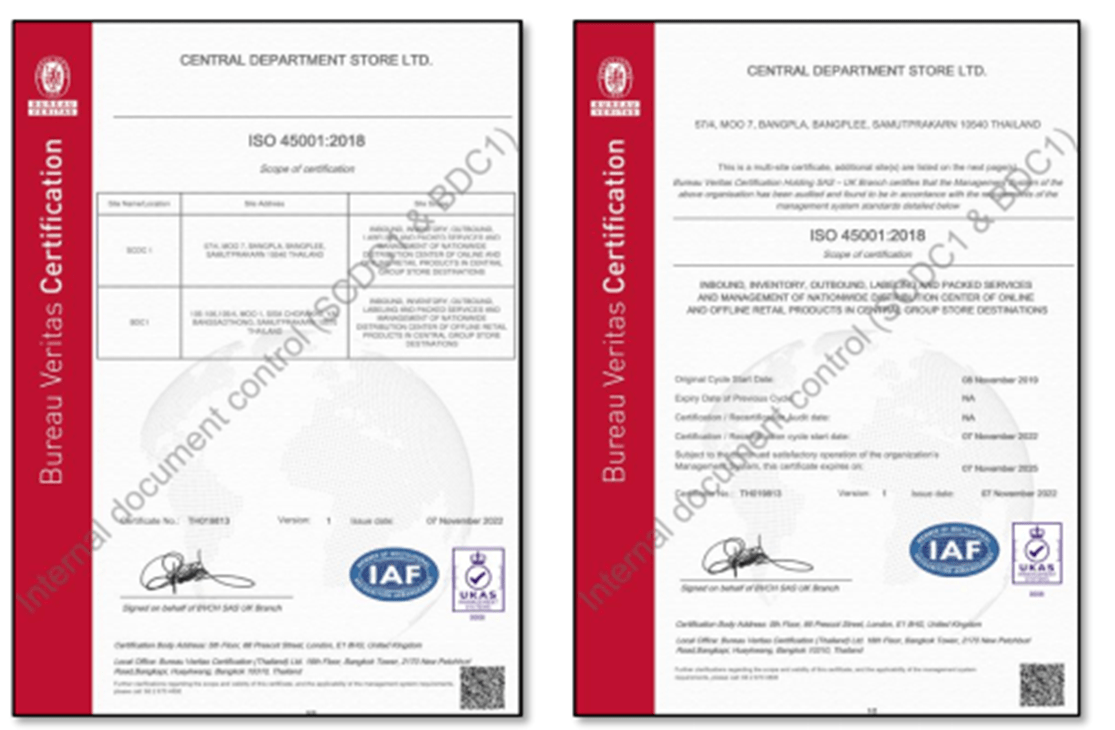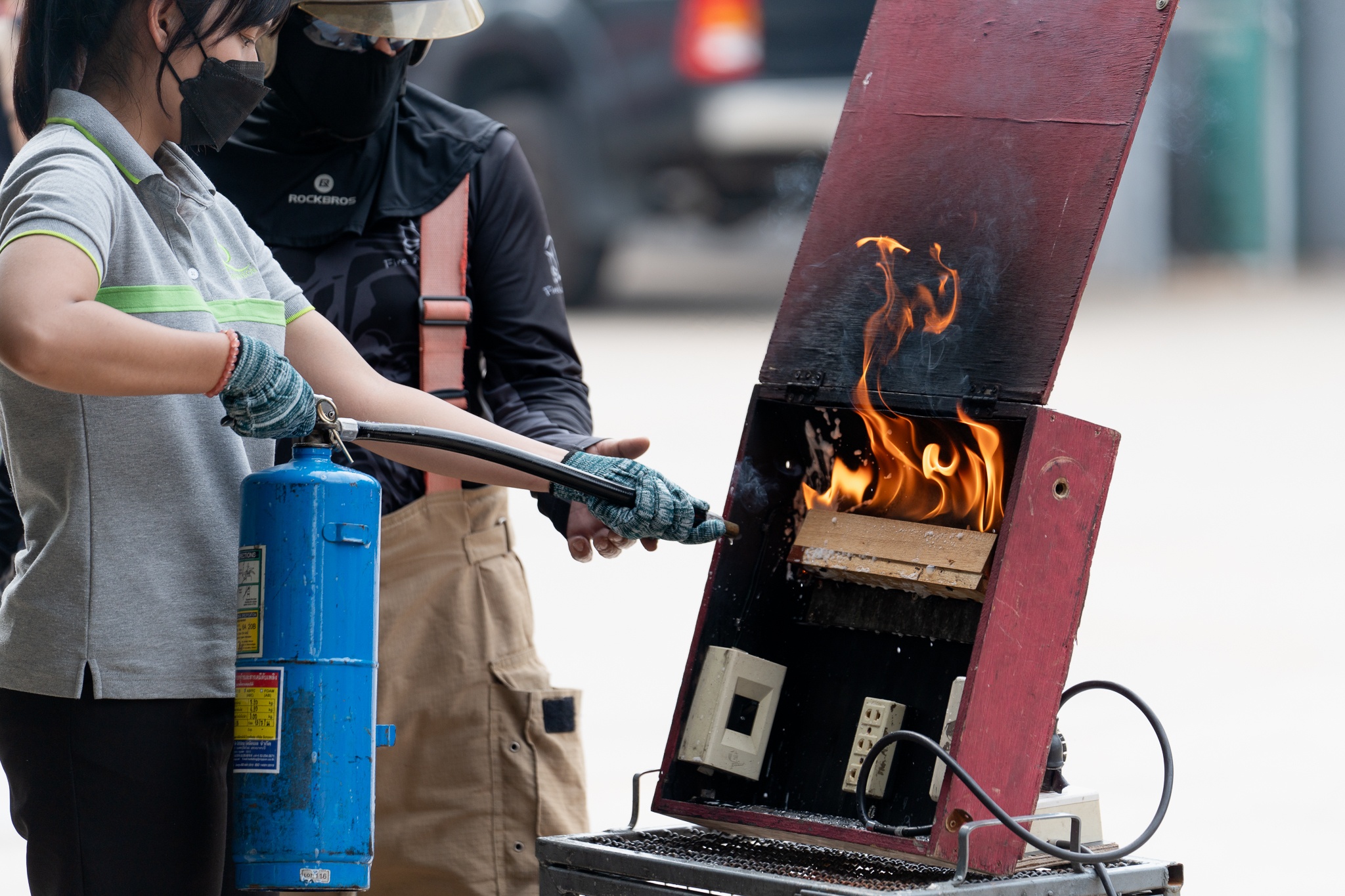Occupational Health and Safety

Central Retail places utmost importance on managing occupational health and safety in the workplace, striving to create a safe working environment by identifying and managing various risks and hazards comprehensively. This includes adhering to laws, regulations, and safety standards related to occupational health and safety both at national and international levels, rigorously. This ensures that all employees and workers receive safety and well-being, leading to continuous and efficient business operations.
Target
Impact to Business, Stakeholders, and Human Rights
Occupational health and safety (OHS) practices have distinct impacts on different stakeholders. For employees, OHS measures ensure workplace safety, reducing accidents and illnesses while fostering job satisfaction. Customers benefit from a secure shopping environment, enhancing their experience and loyalty. Investors and shareholders value companies that prioritize OHS as it signals responsible risk management and can attract investment. Suppliers are encouraged to maintain safe practices throughout the supply chain, fostering stronger partnerships. Regulators enforce OHS standards, ensuring legal compliance and protecting workers' rights. Communities see Central Retail as responsible corporate citizens when they prioritize OHS, enhancing their reputation. Lastly, OHS practices can provide a competitive edge by attracting customers and talent while mitigating risks for businesses.
Management Approach
Central Retail has established an Occupational Safety, Health and Work Environment Policy and mandates that the Head of Human Resource Department, Head of Loss Prevention, and Head of Safety, Occupational Health and Work Environment from each business unit are responsible for overseeing and developing the occupational health and safety management system covering both employees and contractors in all operational areas, including offices, department stores, rental space, and distribution centers. Additionally, Central Retail conducts internal and external audits annually to ensure compliance with legal requirements and international standards as follows:

- ISO 45001: 2018 Occupational Health and Safety Management systems
- Machinery Registration Act, B.E. 2514 (1971)
- Machine Registration Act (No. 3), B.E. 2558 (2015)
- Ministerial Regulation, B.E. 2535 (1992) Issued under the Factory Act, B.E. 2535 (1992)
- Building Control Act, B.E. 2535 (1992)
- Labour Protection Act, B.E. 2566 (2023)
- Occupational Safety, Health, and Environment Act, B.E. 2554 (2011)
- Promotion of Labour Skills Development Act (No. 2), B.E. 2557 (2014)
- Ministerial Regulations and Notification of Departments under Various Acts of Thailand
- Occupational Diseases and Environmental Diseases Control Act B.E. 2562 (2019)
- Legislative Decree No. 81 of 2008 on the Consolidated Law on Health and Safety in the Workplace (Italy business unit)
Occupational Safety, Health and Work Environment Committee of Central Retail consist of branch managers, safety managers, at least two employee representatives, and medical personnel. Their duties include promoting operational compliance and fostering employee participation in implementing various policies and regulations, monitoring results, and continuously improving the efficiency of the occupational safety, health, and work environment management systems. Additionally, the Committee oversees the planning of accident prevention and safety promotion within the relevant branch by organizing Safety Walks. It also keeps an eye on work progress, conducts inspections when work-related illness or injury cases occur, and responds to comments and complaints. The Committee meets monthly and annually to summarize the outcomes of their work, which are obtained through series of consultations and participation of relevant employees. In addition to receiving information on matters relating to work environments and occupational health and safety from employee representatives in the committee, each employee has access to online resources and notifications on the Safety Board in each branch and office, which serve as additional sources of policy, guidelines, and news.
Central Retail has implemented and committed to continually improve OHS practices and management systems to create a safe and healthy work environment for all employees and minimizing the risk of accidents or injuries. The practices include established a clear Occupational Safety, Health and Work Environment Policy, set up an OHS Committee, set targets and action plan to achieve the targets, provides OHS training to employees and contractors, implements a hierarchy of controls to eliminate hazards, prioritize action plan and response measures for emergency situations, and continue to evaluate and monitor hazard and risk in the work environment. With the target set to reduce work-related accidents, Central Retail has plans to manage processes and databases for complete information, to develop prioritization of proactive action plans with quantified targets to address OHS risks. Moreover, Central Retail drives related departments to identify and close the gaps on occupational health and safety issues. An evaluation of progress and milestones will be assessed for further improvements of OHS programs and against targets set. Central Retail effectively implements and maintain a successful Occupational Health and Safety practices and performance with the following management process:
Policy Compliance and Performance Oversight
With the commitment to uphold stringent standards in occupational health and safety, the Head of Human Resource Department and Head of Loss Prevention from each business unit are tasked with conducting annual internal audit and external audits to ensure comply with domestic laws and the ISO 45001 standard across all business operations.
Furthermore, to continue promoting the development of the occupational health and safety management system, relevant departments are required to establish annual quantitative targets, devise action plans to meet these targets, and provide quarterly performance reports to the executive team or Board of Directors.
Occupational Safety, Health and Work Environment Policy
Supplier and Contractor Management
Central Retail ensures that suppliers and contractors adhere to the same occupational health and safety standards as upheld internally. Therefore, Central Retail has established a comprehensive OHS management system that integrates OHS criteria into its procurement and contractual requirements. This criterion is being applied by the procurement team of all business units.
Before engaging in contractual agreements, Central Retail incorporates OHS criteria into all procurement documents and contracts, as well as checking if contractors and suppliers have the necessary OHS licenses and certificates. In the selection process, the procurement team will prioritize and select contractors and suppliers who prioritize safety and have OHS management systems in place by including OHS criteria and requirements in the procurement process. These criteria may include compliance with OHS Regulations, having safety training and providing personal protective equipment. In the contract process, the OHS criteria are also included in the contracts that are signed by contractors and suppliers, with monitoring by Central Retail. By incorporating OHS criteria into its procurement process, Central Retail can mitigate risks, prevent workplace incidents, and create a safer working environment throughout the supply chain.
Hazard Identification, Risk Assessment and Incident Investigation
Safety officers, meticulously selected from the expertise and experience, lead the implementation and enhancement of occupational health and safety management systems. Central Retail requires safety officers and relevant employees to undergo regular training, including enrollment in ISO 45001:2018 Hazard Identification & Risk Assessment courses, annual instruction on relevant laws in each country of operation, and other training that are related every year.
Central Retail's safety officers, tasked with establishing robust processes for hazard identification and risk assessment including potential new operations and projects regarding health and safety issue, provide vital guidelines to evaluate potential workplace risks and their impacts. Furthermore, for work-related injury or illness, Central Retail assumes responsibility for appropriate medical treatment and insurance coverage, with safety officers conducting thorough investigations to determine root causes.
The results of hazard identification, risk assessment, and incident investigation form the basis for developing action plans that focus on risk reduction and prevention of recurrence. These plans are meticulously crafted, incorporating concrete indicators and targets to drive continuous improvement in our occupational health and safety management systems.
Central Retail encourages employee and contractor engagement in these processes through regular communication and training initiatives. Processes are in place to prevent any actions deemed risky and report hazards anonymously through supervisors, line managers, and Help Center for assistance and coordination with relevant departments.
Central Retail has established the hierarchy of controls to systematically eliminate the safety hazards after the hazard identification and risk assessment. This approach, allows to mitigate a wide range of hazards, prioritizing the most effective methods including prevention, substitution, engineering and administrative controls, and investment in personal protective equipment.
Some examples of measures using the hierarchy of controls to mitigate common hazards within Central Retail that may pose risks of work-related injuries and health issues are the following:
| Hazard (Cause of Injury) | Work-related Injury/Ill-Health | Preventive Measure | Substitution Measures | Engineering and Administrative & Control Measures | Personal Protective Equipment |
|---|---|---|---|---|---|
| Slip and fall | Ankle sprain |
|
|
|
Wearing non-slip shoes. |
| Falling off ladders in storage rooms | Broken arm | Automation if applicable. | Switching to a mobile. | Installing guard rails. | Wear head protection. |
| Falling objects in storage rooms | Head injury |
|
|
|
Wear safety shoe |
| Lifting heavy objects | Injuries on the back and legs | Avoid lifting heavy objects without support. |
|
|
|
| High mental demand of certain tasks | Work-related stress and mental health issues | Prevent long working hours for tasks with high mental demand. | Encourage work-life balance by promoting flexible working arrangements |
|
|
| Infectious diseases | Getting symptoms of infectious diseases and increase risk of infecting to other employees. |
|
Remote work, or social distancing. |
|
|
| A long period of constant work | Office Syndrome | Organize the working space to Ergonomic design | Work with appropriate posture and increase movement while working |
|
|
| Shopping Cart hits people | Hit the feet, legs, or body |
|
|
|
Wearing closed-toe shoes with non-slip soles can help prevent foot injuries. |
Occupational Health and Safety Trainings
Collaboration among the Human Resource Department, Loss Prevention Department, and each business unit organized online and on-site occupational health and safety training for employees. The curriculum includes both mandatory topics as direction of the law, especially in Italy, and voluntary parts. Training topics include hazard identification, risk and danger assessment, work safety manuals, and warehouse case studies. In addition, drivers and delivery personnel will be trained in safe driving or riding techniques. Furthermore, each business unit's Human Resource Department, Loss Prevention Department and Occupational Health and Safety Department are in charge of collecting occupational health and safety data to develop the training subjects.
Promoting occupational health and safety in operations
Central Retail facilitates access to services that are related to occupational health and safety, medical and healthcare for employees and contractors. First aid rooms are prepared in each of Central Retail's properties for employees' health welfare reimbursement. Also, Help Center channel is provided for health advice from professional nurses and requests for further assistance.
Alongside the previous initiatives, Central Retail's Italy business unit takes additional steps to prioritize the health and well-being of its employees by offering non-occupational medical and health care services. These voluntary health promotion services and programs are designed to enhance employee's wellness and vitality. It encompasses various initiatives such as 'Safe Zone' mental health talk sessions, discounted fitness memberships, consultations on breast cancer, dermatological check-ups conducted in collaboration with major hospitals, as well as access to private and contracted medical services for employees with supplementary insurance coverage.
Moreover, Central Retail places a strong emphasis on extending occupational health and safety measures to encompass suppliers and contractors. Central Retail commits to mitigate risks and ensure a safe working environment for all stakeholders. This commitment is demonstrated through strict compliance with Central Retail's occupational health and safety protocols, including the requirement for suppliers and contractors to adhere to appropriate personal protective equipment (PPE) standards. By fostering a culture of safety and collaboration, Central Retail aims to create a sustainable workplace that prioritizes the well-being of everyone involved.
In addition, Central Retail continuously improve its OHS management system by the following approaches:
- Stay up to date with emerging OHS regulations and best practices.
- Encourage employees to suggest new ideas and approaches to improve workplace safety.
- Conduct regular audits and inspections to assess the effectiveness of OHS controls.
- Continuously review and update OHS management approach to reflect changing regulations and industry best practices as needed.
Project Highlights

Safety and Emergency Trainings
Central Retail provides regular training on safety and emergency response to both new and existing employees to ensure they can appropriately respond to various situations, reducing injuries and fatalities for both employees, contractors, and customers.
The training program includes basic first aid and cardiopulmonary resuscitation (CPR) with automated external defibrillator (AED) training for employees working within department stores. This training helps employees become familiar with the procedures for first aid and basic life support (CPR) and using an AED, which are crucial skills in assisting others in sudden cardiac arrest situations. In 2022, training was provided to 1,400 employees working in Central Retail and Robinson department stores.
Additionally, there is a fire safety training program for all business units and distribution centers to ensure employees understand and can respond to potential fire situations. Employees learn how to use fire extinguishers, practice evacuation drills, and learn how to assist others.
Central Retail also recognizes the importance of active shooter incidents, thus providing active shooter response training to department store employees. This training equips employees with communication and emergency response strategies to handle such situations, ensuring confidence in safety for both employees and customers. Employees must pass the training with a minimum score of 80% to be certified.







